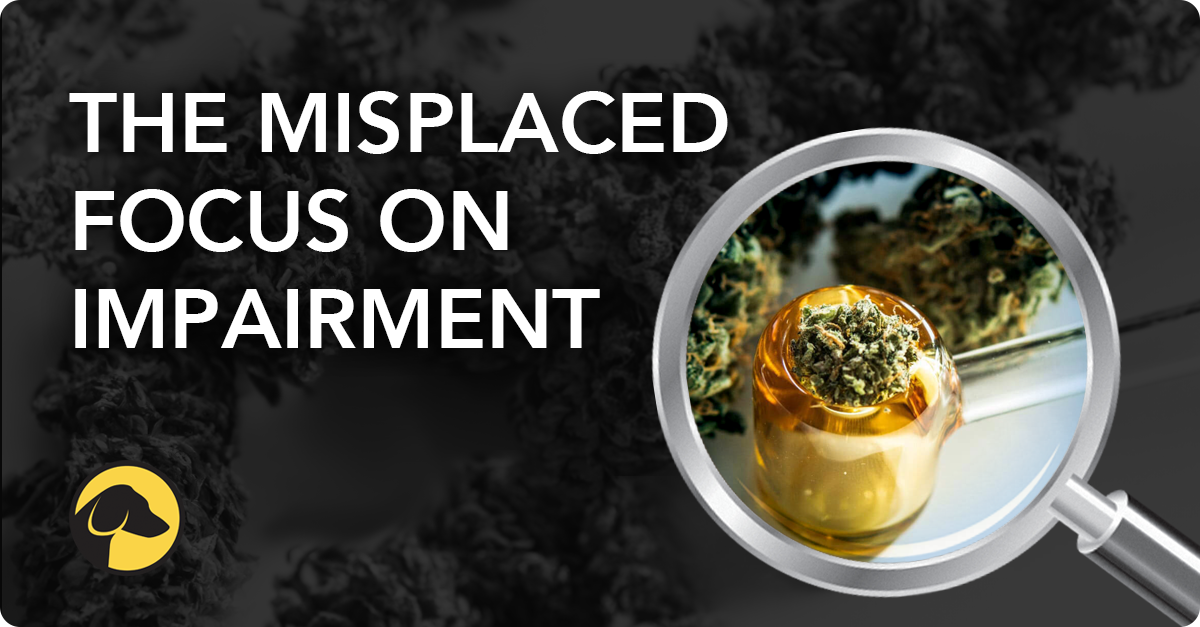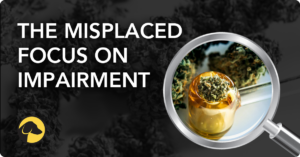
How a Misplaced Focus on Impairment Creates Risk + Financial Strategy Gaps
Emerging cannabis laws and legacy drug testing technologies with long cannabis detection windows are presenting new challenges for employers as they endeavor to deter cannabis use, maintain safe workplaces, and ensure employees are treated fairly.
To address workplace safety, some legislators and organizations have introduced a series of new laws and testing methods increasingly focused on identifying the signs of impairment. But when it comes to cannabis, no test in the market is capable of detecting impairment and there is no agreed-upon standard or definition for what constitutes impairment. Furthermore, laws based on impairment may be vague and open to interpretation because legislators have likely written them based on their own state’s definitions and measures for impairment.
The result is a confusing mixed bag of messages for employers, Consumer Reporting Agencies (CRAs), and Third Party Administrators (TPAs) which unfortunately limits them from optimizing the real intent of drug testing – deterring drug use among employees before or during work hours.
THE ALCOHOL EFFECT
Part of the confusion around impairment stems from an attempt to make a direct comparison between alcohol and THC. In most states and in Washington, D.C., it’s illegal to operate a vehicle while having a Blood Alcohol Concentration (BAC) of 0.08% or greater. Someone with a high tolerance to alcohol, however, may not experience safety-impacting effects at that level, but they could still be cited for driving under the influence based on the quantitative standard.
Research over decades shows that, on average, alcohol follows an established post-consumption metabolization pattern. Because of this, states can rely on a per se law that makes it illegal in and of itself to operate a motor vehicle at or above the established BAC level, regardless of whether the driver exhibits visible signs of safety-impacting behaviors.
“The legislators drafting this language may have thought of [THC] like alcohol, and there’s a legal, per se, limit for alcohol,” says Dr. Barry Sample, a leading workforce drug testing expert. “So, why couldn’t they do the same thing for cannabis? Well, we know that the science and the technology just aren’t there to support that same determination.”
Cannabis is more complicated than alcohol due, in large part, to its variable routes of administration. Additionally, cannabis is classified as a Schedule I drug which has prevented some of the research necessary to determine a quantitative standard under which a user would be considered impaired.
PURPOSE AND INTENT
Workplace drug testing is not and has never been about detecting impairment; rather, it serves as a risk mitigation tool providing an objective measure to reinforce an employer’s testing policy. However, accompanying the increase in employee access to cannabis, the discussion around impairment seems to be in constant debate. Impairment is complex, though, and the cause of impairment can be difficult to determine. Additionally, it is not a defined standard.
Technology is racing to the market to help employers identify impairment caused by cannabis; but in reality, impairment is not the issue. Instead, the real issue is the timeframe in which an employee has used cannabis and its proximity to the workday.
In light of this, a forward-thinking strategy is to build cannabis testing policies around deterrence, remembering the goal of deterrence is a zero percent positivity rate during the workday; not a zero-tolerance policy related to employee use. In the era of cannabis legalization, adapting policies in this manner may require a shift away from traditional test types.
Historically, employers have relied on biological samples such as oral fluid, urine, and hair to detect the absence (or confirm the presence) of cannabis in an employee’s system. These tests demonstrate the validity of using biological samples to provide objective data about an employee’s cannabis use. However, because of their long detection windows, they are no longer practical or enforceable in the era of cannabis legalization. In fact, some states have limited the use of these test types to prevent employment discrimination against employees who use cannabis off-duty and away from work.
THE DRUG TEST RESELLER IMPACT
What this demonstrates to the screening industry is that employers need a new biological sample type like breath to provide objective, relevant data about recent cannabis use. These results can help employers identify use that has real potential to negatively impact an employee’s workday, instead of relying on a false impairment narrative.
Based on an organization’s objectives, breath testing can be added in a variety of scenarios and testing timeframes including random, post-incident, reasonable suspicion, pre-employment, onboarding, pre-access, and return-to-duty. With one in six Americans saying they “smoke marijuana” according to Gallup’s 2023 Consumption Habits survey, shifting the focus of testing from mostly pre-employment to post-hire testing throughout the continuum of employment may help reinforce an employer’s long-term policy and prevention program.
It’s critical for resellers – both CRAs and TPAs – to consult with and guide clients and prospects who rely upon workplace drug testing as the cornerstone of their risk mitigation strategy but who feel challenged by cannabis-related legislative changes. It’s simply too difficult for employers to navigate this environment on their own, especially when they hear conflicting messages from legislators. Innovative screening providers who understand the limitations of impairment-related laws, and who can effectively communicate the goal of deterrence to support employer’s needs, play an invaluable role in helping their clients succeed.
For more information on cannabis breath testing, please contact our sales team.
This blog originally appeared in the Nov/Dec 2023 issue of the PBSA Journal.

May 2, 2024
By AARON ATKINSON
EXECUTIVE VICE PRESIDENT OF MARKETING
Share











